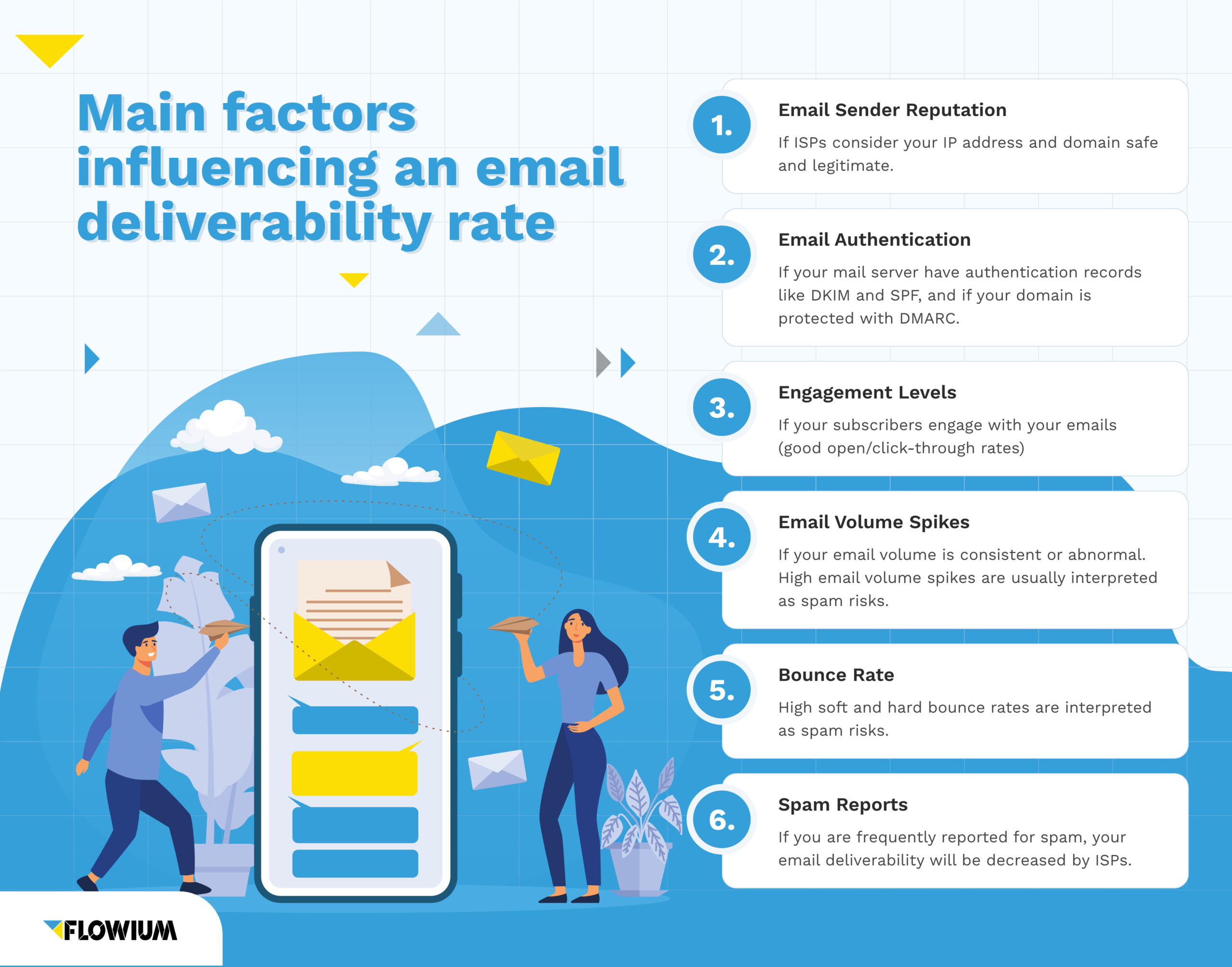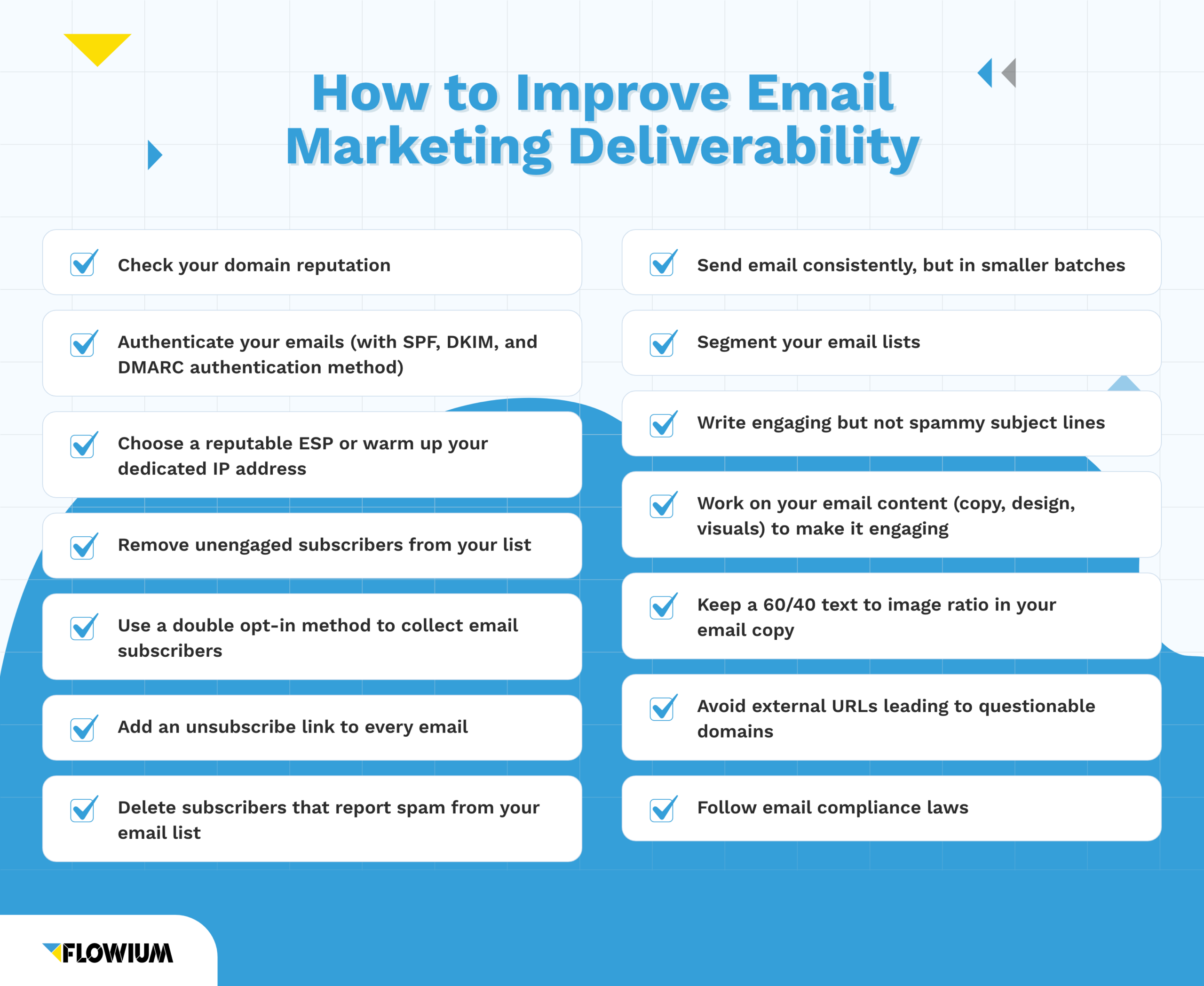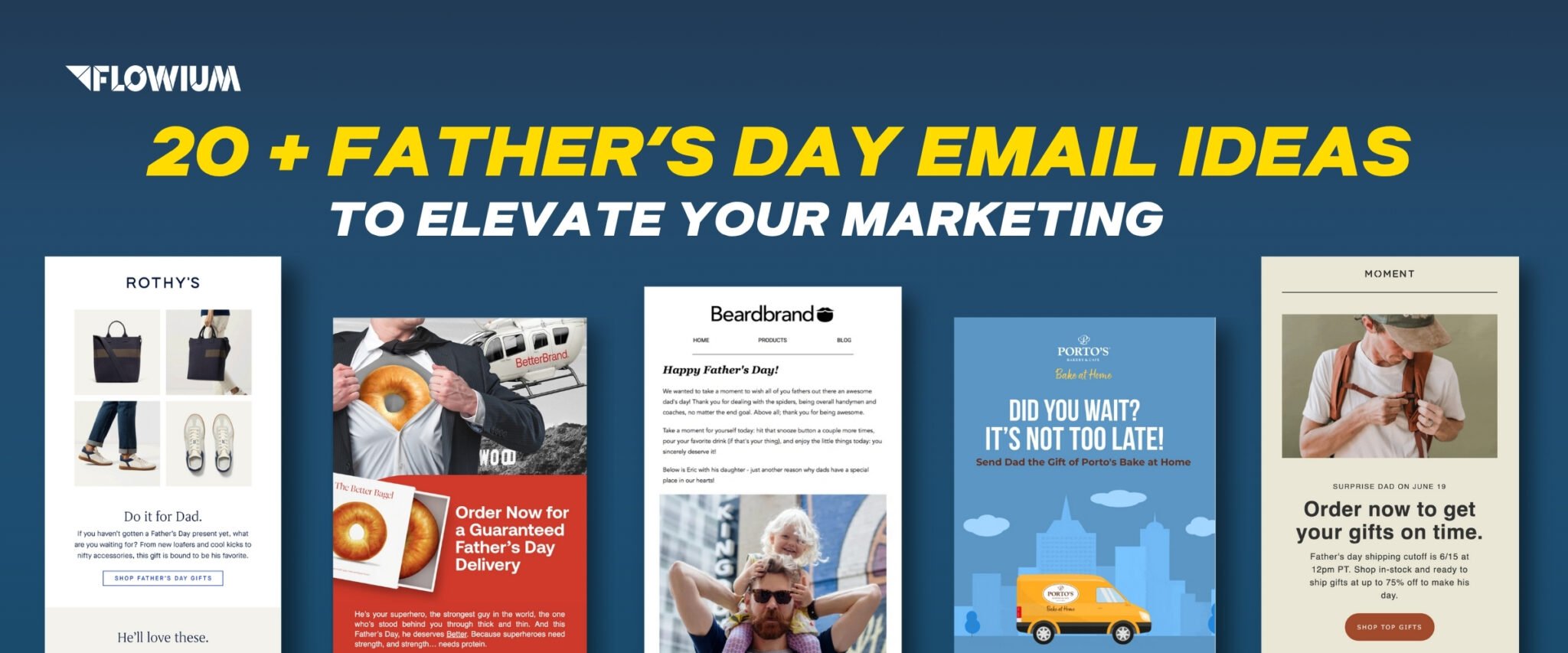Sending marketing emails to your subscribers may seem like a straightforward task. Create an email campaign, hit send, and deliver straight to your subscriber’s inbox. But in reality, there are many hidden obstacles that can prevent your email from reaching its destination.
Spam filters, server limitations, and other factors can cause your email to be flagged as spam or lost along the way.
So, is there anything you can do to make sure that your emails are successfully delivered to your subscribers’ inboxes and not flagged as spam?
Luckily, yes. There are a few things you can do to improve your email deliverability. And that’s what we’re going to cover in this guide.
What is Email Deliverability?
Emails are like modern-day carrier pigeons that deliver messages across the digital world. And just like pigeons, not all of them reach their destination. Some of them fly freely into the customer inboxes, while others get trapped in their spam folders or somewhere along the digital way.
That’s what email deliverability is: the ability of an email to land in the intended user’s inbox.
As a metric, it’s the percentage of emails that get delivered to their recipients out of all the emails that have been sent.
Your ISP (Internet Service Provider), ESP (Email Service Provider), and IPS (Intrusion Prevention System) all have a deciding hand over which emails get delivered and which get marked as spam.
In case you don’t fully know the difference between them, here’s a quick explanation:
- An ISP is a company that connects you to the internet.
- An ESP is a company that helps you send and manage your email campaigns.
- An IPS is a software that helps protect computer networks from security threats.
These providers evaluate various factors to determine whether the email can successfully land in its intended recipient’s inbox, or whether it should be considered spam.
These criteria include the sender’s reputation, domain authority, email content, subject line, spam words, and even the frequency of emails being sent.
Why email deliverability can be an issue for the sender
A low email deliverability rate is a critical issue for both the ISP and the sender. If too many unsolicited or irrelevant emails are allowed to infiltrate their users’ inboxes, it can decrease customer satisfaction and trust.
From the point of view of email senders, being marked as spam will make it more difficult for their future emails to land in their customers’ inboxes. Their customers won’t even see their emails, leading to low open and click rates.
As a result, their email list will become nearly unresponsive, which will damage their reputation over time and increase the chances of their emails being marked as spam again. This creates a cycle that’s almost impossible to break.

What is a Good Email Deliverability Rate
Are all of your emails reaching their intended recipients? Chances are, some get lost on the way to your subscribers’ inboxes or get flagged as spam.
While the ideal scenario would be to achieve a 100% deliverability rate, that’s very hard to achieve. In reality, anything over 90% is considered a good email deliverability rate. That’s what you should be aiming for.
You can find out what your number is in your email marketing platform’s analytics dashboard or by doing some quick math using your sent and bounced email numbers.

Average marketing emails deliverability rate
In practice, your email deliverability rate will heavily depend on the industry you’re in. Some industries experience a higher spam rate than others.
According to Statista, in 2022, almost half of all e-mails sent worldwide were marked as spam. In another report, Statista also concluded that the emails sent in the job & career and finance industries had the highest spam rates of around 14%.
So, what’s the average email deliverability rate for marketing emails? It’s hard to say. But this study by EmailToolTester claims that as of April 2022, it was hovering around 84.2% across all the email marketing platforms they tested.
Main factors influencing an email deliverability rate
There are many elements that can affect your email deliverability rate as a whole. The main ones are:
- Email sender reputation,
- Authentication,
- Engagement levels,
- Email volume spikes,
- Bounce rate, and
- Spam reports.
We’ll go over these elements later in the article and explain how each of them affects your email deliverability – and what you can do to fix it.
How to Check Your Email Deliverability
Checking email deliverability is a must if you want to know whether your emails are landing in your customers’ inboxes. There are many ways to do that, but the most time-efficient is using an email deliverability tool.
The tool we use to check email deliverability for our clients (and ourselves) is Email on Acid. There are other email testing tools, like Litmus or SendPost, but this one is our favorite.

Here’s how we use it to check the deliverability of our or our clients’ emails:
- Step 1: Once you’ve logged in to Email on Acid, go to Spam Testing. Select the “I will send each test email from my ESP using the provided seed list” option and copy all of the email addresses listed in the field.
- Step 2: Go to your email provider and send a test email to the seed list. Once you’ve done that, wait a few minutes and click “Run Spam Test” in the Email on Acid’s dashboard.
- Step 3: Once the results start populating, you’ll be able to see your results for B2B, B2C, and overall deliverability. The goal is to achieve 100% deliverability.
You can do this test with different types of email campaigns you send to your list. This way, you’ll be able to identify which campaigns are problematic.
How to Improve Email Deliverability
There are several things you can do to make sure that your emails don’t vanish into the abyss of your recipients’ spam boxes. Improving the deliverability of your emails comes down to these three areas:
- Building and maintaining a good sender reputation,
- Maintaining a clean email infrastructure, and
- Creating quality emails that are valuable to your subscribers.
Let’s go over some of the best practices to keep your email deliverability as close to 100% as possible.
Be aware of your IP address and domain reputation
Building a good sender reputation is key to making sure that your emails actually reach your subscribers’ inboxes.
Your sender reputation is like your email passport – it tells your ISP whether you’re a trusted sender or a shady character. There are two things that build your sender reputation: your IP address reputation and your domain reputation.
Your IP reputation tells your ISP how legit and trustworthy is the IP address you’re sending your emails from.
👉 If you’ve got a sketchy history of sending spam or other shady emails, ISPs will likely flag your IP address as untrustworthy. On the other hand, if you follow proper sending practices and send high-quality, engaging emails, your IP reputation will be much stronger.
Your domain reputation is based on the quality of the email authentication and verification measures associated with your sending domain.
These measures help ISPs determine whether your emails are legit and should be delivered to their users’ inboxes.
To check the state of your IP address and domain reputation, you can use this tool by MxToolbox.
One way to make sure you’re building and maintaining a positive sender reputation is by using a reputable email service provider (ESP).
And if you aren’t, warm up your IP address before you start sending high volumes of emails. Starting with small batches of emails and gradually increasing the volume over time will give ISPs a chance to get to know you and recognize you as a legitimate sender.
Authenticate your emails
Authenticating your emails may be a bit complex if you’re not a techie person. For most marketers that aren’t experts in the technical aspect of email marketing, terms like SPF, DKIM, and DMARC sound like they are taken straight from a sci-fi movie about cyberspace.
But fear not! You don’t have to be a tech guru to authenticate your emails. SPF, DKIM, and DMARC are simply email authentication protocols that you have to set up currently in your email server.
But just to make sure you know what we’re talking about, let’s briefly explain these terms:
- SPF stands for Sender Policy Framework, and it’s an email authentication protocol that verifies if the email server sending a message is authorized to do so on behalf of a particular domain.
- DKIM stands for DomainKeys Identified Mail, and it’s another email authentication method. It uses a digital signature to verify the sender’s identity and message integrity.
- DMARC stands for Domain-based Message Authentication, Reporting & Conformance. It’s yet another email authentication protocol that uses SPF and DKIM to determine whether an email message is legitimate.
Now, the problem begins if these authentication protocols are missing or are misconfigured in your email service.
Keep your email list clean
Bad email list hygiene is a common issue that affects email deliverability. In email marketing, it refers to practices like purchasing lists or subscribers, skipping double opt-in and neglecting email verification.
These actions can lead to a buildup of invalid or inactive email addresses, which will inevitably lead to higher bounce rates and low engagement rates. This will make your IPS (Intrusion Prevention System) think your emails aren’t legit. As a result, your campaigns will end up in your subscribers’ spam inboxes.
👉 You can prevent this by avoiding bad practices like buying subscribers and regularly cleaning your list.
Periodically removing unengaged subscribers and identifying invalid email addresses will limit your hard bounce rate (the percentage of emails that couldn’t be delivered because the email address was invalid or non-existent).
Sometimes, people will use a fake email address to get their hands on your lead magnet or free trial without any genuine interest in what you offer. To prevent this, using a double opt-in process where they confirm their subscription can cut down on those pesky fake email addresses and help you maintain a high-quality email list.
Another thing you can do to keep your email list in top shape is to include an unsubscribe link in your emails (you must do so anyways to comply with regulations!).
If a subscriber complains about spam, take them off your email list right away. By simply unsubscribing them from your list internally, you can prevent them from causing damage to your reputation down the line.
Send emails consistently but in smaller batches
If you send too many emails too quickly, your ESP and ISP are likely to interpret them as spam.
And no one wants spam sent or received through their platform, which is why many ESPs enforce a daily limit of emails you’re allowed to send. ISPs do the same by limiting the number of emails they accept from the same IP address within a set timeframe.
Not respecting these limits can cause a high soft bounce rate.
💡 A soft bounce rate is when an email message is returned to the sender because of a temporary delivery failure, such as a full inbox or a server issue. It has a solution, which is why it’s called a “soft” bounce rate, but if it’s too high, it can easily hurt your sender reputation and impact your email deliverability.
To avoid these issues, send your email campaigns in small batches by segmenting your list, and follow a consistent sending schedule and frequency to avoid abnormal spikes.
This will also help you keep your subscribers engaged! If they only receive emails from you once in a blue moon, they’re more likely to forget who you are and flag your emails as spam.
Work on your emails to boost engagement
ESPs and ISPs often determine how trustworthy and legit an email is by looking at the engagement that the previous emails from this sender generated.
Some mailbox providers like Gmail, AOL, and Hotmail look at recipient engagement to judge your sending reputation. Engagement can be anything from open and click-through rates to replies and forwards.
So, make sure that the emails you send are something your subscribers will genuinely want to engage with. Crafting an email that people will love is an art, and like any artist, you need to master several elements of your email composition.
Delivering valuable and relevant content to your subscribers is the first step, but it’s not enough.
You must also pay attention to your subject lines and make sure they’re closely related to the email content. Avoid over-sensationalizing and over-promising subject lines that include spammy and clickbait-y words like “free,” “order now,” or “best price.”
Aside from your email content and subject line, your email design also plays a vital role in your email deliverability. A best practice is to have a 60/40 text-to-image ratio to avoid deliverability issues.
Follow email compliance laws
Emails that don’t adhere to international email compliance regulations will be quickly flagged as spam. So, following these laws can help you maintain a good email deliverability rate.
Two important email compliance laws you must pay attention to are GDPR and CCPA.
💡 You probably already know this, but GDPR applies to companies that process the personal data of EU citizens, while the CCPA applies to companies that operate in California and collect personal information from California residents.
If you want to avoid any legal mishaps and having your emails marked as spam, you must be fully transparent about how you collect and process your subscribers’ data.
A few things you should keep in mind is making sure you have explicit consent from your subscribers to send them emails. Obtaining people’s email addresses and sending them emails without their permission is an absolute no-no!
You should also give them an easy way to opt out of your email list by including an unsubscribe link where they can easily see and access it. While most email marketers hide this link in a tiny font at the bottom of the email, this isn’t the healthiest practice.
For more detailed information about the requirements, head over to the official GDPR and CCPA websites.
Email Deliverability Checklist
We’ve covered a lot of valuable information in this guide to help you maintain a high email deliverability rate. If you follow these recommendations to a T, you’ll easily achieve a rate of over 90%.
However, we understand this can be a lot to take in and memorize! So, we’ve created a handy email deliverability checklist you can use to make sure that no important practices slip your mind.

FAQs about Email Deliverability
Start by identifying the root cause, which could be anything from poor engagement rates to authentication problems. Once you know what’s causing your deliverability issues, you can take steps to address them.
The easiest and most time-efficient way to check your email deliverability is to use an email testing tool. There are many, but we recommend Email on Acid – that’s the one we use.
Ideally, your email deliverability score should be over 90%. Anything below it is considered a poor email deliverability score and should be addressed. This is the number you should be aiming for regardless of the industry you’re in!







